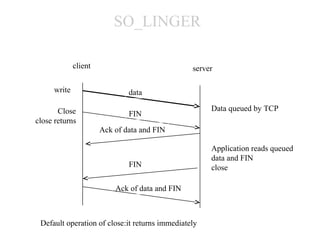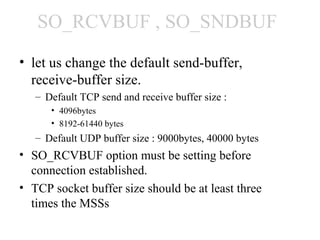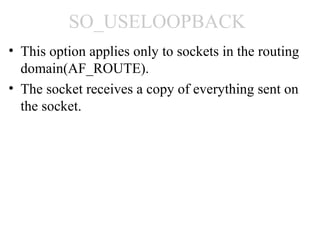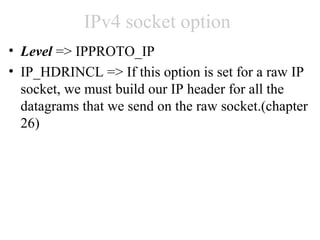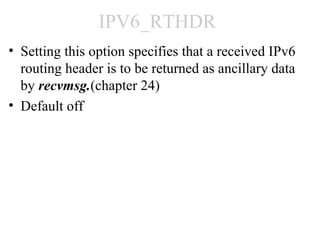Ad
Np unit iv ii
- 2. abstraction • Introduction • getsockopt and setsockopt function • socket state • Generic socket option • IPv4 socket option • ICMPv6 socket option • IPv6 socket option • TCP socket option
- 3. Introduction • Three ways to get and set the socket option that affect a socket – getsockopt , setsockopt function=>IPv4 and IPv6 multicasting options – fcntl function =>nonblocking I/O, signal driven I/O
- 4. getsockopt and setsockopt function #include <sys/socket.h> int getsockopt(int sockfd, , int level, int optname, void *optval, socklent_t *optlen); int setsockopt(int sockfd, int level , int optname, const void *optval, socklent_t optlen); •sockfd => open socket descriptor •level => code in the system to interprete the option(generic, IPv4, IPv6, TCP) •optval => pointer to a variable from which the new value of option is fetched by setsockopt, or into which the current value of the option is stored by setsockopt. •optlen => the size of the option variable.
- 5. Generic socket option • SO_BROCAST =>enable or disable the ability of the process to send broadcast message.(only datagram socket : Ethernet, token ring..) :chapter18 • SO_DEBUG =>kernel keep track of detailed information about all packets sent or received by TCP(only supported by TCP) • SO_DONTROUTE=>outgoing packets are to bypass the normal routing mechanisms of the underlying protocol. • SO_ERROR=>when error occurs on a socket, the protocol module in a Berkeley-derived kernel sets a variable named so_error for that socket. Process can obtain the value of so_error by fetching the SO_ERROR socket option
- 6. SO_KEEPALIVE • SO_KEEPALIVE=> • When the keep-alive option is set for a TCP socket and no data has been exchanged across the socket in either direction for two hours, TCP automatically sends a keep- alive probe to the peer. • wait 2hours, and then TCP automatically sends a keepalive probe to the peer. – Peer response • ACK(everything OK) • RST(peer crashed and rebooted):ECONNRESET • no response:ETIMEOUT =>socket closed – example: Rlogin, Telnet…
- 7. SO_LINGER • SO_LINGER =>specify how the close function operates for a connection-oriented protocol(default:close returns immediately) – struct linger{ int l_onoff; /* 0 = off, nonzero = on */ int l_linger; /*linger time : second*/ }; • l_onoff = 0 : turn off , l_linger is ignored • l_onoff = nonzero and l_linger is 0:TCP abort the connection, discard any remaining data in send buffer. • l_onoff = nonzero and l_linger is nonzero : process wait until remained data sending, or until linger time expired. If socket has been set nonblocking it will not wait for the close to complete, even if linger time is nonzero.
- 8. SO_LINGER client server write data Close Data queued by TCP FIN close returns Ack of data and FIN Application reads queued data and FIN FIN close Ack of data and FIN Default operation of close:it returns immediately
- 9. SO_LINGER client server write data Close Data queued by TCP FIN Ack of data and FIN close returns Application reads queued data and FIN FIN close Ack of data and FIN Close with SO_LINGER socket option set and l_linger a positive value
- 10. SO_LINGER client server write data Shutdown Data queued by TCP FIN read block Ack of data and FIN Application reads queued data and FIN FIN close read returns 0 Ack of data and FIN Using shutdown to know that peer has received our data
- 11. • A way to know that the peer application has read the data – use an application-level ack or application ACK – client char ack; Write(sockfd, data, nbytes); // data from client to server n=Read(sockfd, &ack, 1); // wait for application-level ack – server nbytes=Read(sockfd, buff, sizeof(buff)); //data from client //server verifies it received the correct amount of data from // the client Write(sockfd, “”, 1);//server’s ACK back to client
- 14. SO_RCVBUF , SO_SNDBUF • let us change the default send-buffer, receive-buffer size. – Default TCP send and receive buffer size : • 4096bytes • 8192-61440 bytes – Default UDP buffer size : 9000bytes, 40000 bytes • SO_RCVBUF option must be setting before connection established. • TCP socket buffer size should be at least three times the MSSs
- 15. SO_RCVLOWAT , SO_SNDLOWAT • Every socket has a receive low-water mark and send low-water mark.(used by select function) • Receive low-water mark: – the amount of data that must be in the socket receive buffer for select to return “readable”. – Default receive low-water mark : 1 for TCP and UDP • Send low-water mark: – the amount of available space that must exist in the socket send buffer for select to return “writable” – Default send low-water mark : 2048 for TCP – UDP send buffer never change because dose not keep a copy of send datagram.
- 16. SO_RCVTIMEO, SO_SNDTIMEO • allow us to place a timeout on socket receives and sends. • Default disabled
- 17. SO_REUSEADDR, SO_REUSEPORT • Allow a listening server to start and bind its well known port even if previously established connection exist that use this port as their local port. • Allow multiple instance of the same server to be started on the same port, as long as each instance binds a different local IP address. • Allow a single process to bind the same port to multiple sockets, as long as each bind specifies a different local IP address. • Allow completely duplicate bindings : multicasting
- 18. SO_TYPE • Return the socket type. • Returned value is such as SOCK_STREAM, SOCK_DGRAM...
- 19. SO_USELOOPBACK • This option applies only to sockets in the routing domain(AF_ROUTE). • The socket receives a copy of everything sent on the socket.
- 20. IPv4 socket option • Level => IPPROTO_IP • IP_HDRINCL => If this option is set for a raw IP socket, we must build our IP header for all the datagrams that we send on the raw socket.(chapter 26)
- 21. When this option is set, we build a complete IP header, with the following exception: • IP always calculates and stores the IP header checksum. • If we set the IP identification field to 0, the kernel will set the field. • If the source IP address is INADDR_ANY, IP sets it to the primary IP address of the outgoing interface. • Setting IP options is implementation-dependent. Some implementations take any IP options that were set using the IP_OPTIONS socket option and append these to the header that we build, while others require our header to also contain any desired IP options. • Some fields must be in host byte order, and some in network byte order. This is implementation-dependent, which makes writing raw packets with IP_HDRINCL not as portable as we'd like.
- 22. • IP_OPTIONS=>allows us to set IP option in IPv4 header.(chapter 24) • IP_RECVDSTADDR=>This socket option causes the destination IP address of a received UDP datagram to be returned as additional data by recvmsg.(chapter20)
- 23. IP_RECVIF • Cause the index of the interface on which a UDP datagram is received to be returned as ancillary data by recvmsg.(chapter20)
- 24. IP_TOS • lets us set the type-of-service(TOS) field in IP header for a TCP or UDP socket. • If we call getsockopt for this option, the current value that would be placed into the TOS(type of service) field in the IP header is returned.(figure A.1)
- 25. IP_TTL • We can set and fetch the default TTL(time to live field)for unicast. • With this option, we can set and fetch the default TTL that the system will use for unicast packets sent on a given socket. (The multicast TTL is set using the IP_MULTICAST_TTL socket option)
- 26. ICMPv6 socket option • This socket option is processed by ICMPv6 and has a level of IPPROTO_ICMPV6. • ICMP6_FILTER =>lets us fetch and set an icmp6_filter structure that specifies which of the 256possible ICMPv6 message types are passed to the process on a raw socket.(chapter 25)
- 27. IPv6 socket option • This socket option is processed by IPv6 and have a level of IPPROTO_IPV6. • IPV6_ADDRFORM=>allow a socket to be converted from IPv4 to IPv6 or vice versa. (chapter 10) • IPV6_CHECKSUM=>specifies the byte offset into the user data of where the checksum field is located.
- 28. IPV6_DSTOPTS • Specifies that any received IPv6 destination options are to be returned as ancillary data by recvmsg.
- 29. IPV6_HOPLIMIT • Setting this option specifies that the received hop limit field be returned as ancillary data by recvmsg.(chapter 20) • Default off.
- 30. IPV6_HOPOPTS • Setting this option specifies that any received IPv6 hop-by-hop option are to be returned as ancillary data by recvmsg.(chapter 24)
- 31. IPV6_NEXTHOP • This is not a socket option but the type of an ancillary data object that can be specified to sendmsg. This object specifies the next-hop address for a datagram as a socket address structure.(chapter20)
- 32. IPV6_PKTINFO • Setting this option specifies that the following two pieces of infoemation about a received IPv6 datagram are to be returned as ancillary data by recvmsg:the destination IPv6 address and the arriving interface index.(chapter 20)
- 33. IPV6_PKTOPTIONS • Most of the IPv6 socket options assume a UDP socket with the information being passed between the kernel and the application using ancillary data with recvmsg and sendmsg. • A TCP socket fetch and store these values using IPV6_ PKTOPTIONS socket option.
- 34. IPV6_RTHDR • Setting this option specifies that a received IPv6 routing header is to be returned as ancillary data by recvmsg.(chapter 24) • Default off
- 35. IPV6_UNICAST_HOPS • This is similar to the IPv4 IP_TTL. • Specifies the default hop limit for outgoing datagram sent on the socket, while fetching the socket option returns the value for the hop limit that the kernel will use for the socket.
- 36. TCP socket option • There are five socket option for TCP, but three are new with Posix.1g and not widely supported. • Specify the level as IPPROTO_TCP.
- 37. TCP_KEEPALIVE • This is new with Posix.1g • It specifies the idle time in second for the connection before TCP starts sending keepalive probe. • Default 2hours • this option is effective only when the SO_KEEPALIVE socket option enabled.
- 38. TCP_MAXRT • This is new with Posix.1g. • It specifies the amount of time in seconds before a connection is broken once TCP starts retransmitting data. – 0 : use default – -1:retransmit forever – positive value:rounded up to next transmission time
- 39. TCP_MAXSEG • This allows us to fetch or set the maximum segment size(MSS) for TCP connection.
- 40. TCP_NODELAY • This option disables TCP’s Nagle algorithm. (default this algorithm enabled) • purpose of the Nagle algorithm. ==>prevent a connection from having multiple small packets outstanding at any time. • Small packet => any packet smaller than MSS.
- 41. Nagle algorithm • Default enabled. • Reduce the number of small packet on the WAN. • If given connection has outstanding data , then no small packet data will be sent on connection until the existing data is acknowledged.
- 42. Nagle algorithm disabled Nagle algorithm disabled h 0 e 250 l 500 l 750 o 1000 ! 1250 1500 1500 1750 2000
- 43. Nagle algorithm enabled h h 0 e 250 l 500 el l 750 o 1000 ! 1250 lo 1500 1500 1750 ! 2000 2250 2500







